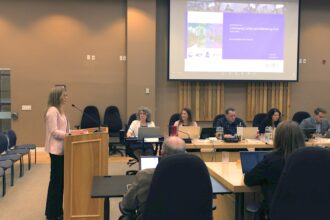In a devastating window into Canada’s ongoing overdose crisis, harrowing details have emerged from the 911 call made after University of Victoria student Abigail McDonald was found unresponsive in her residence last March. The coroner’s inquest, which began this week, played the audio recording that captures the frantic moments as friends and first responders fought to save the 16-year-old’s life.
“You need to start CPR right now,” the 911 operator instructed McDonald’s roommate, who discovered her unconscious around 10:30 p.m. on March 4, 2023. The distress in the caller’s voice was palpable as she and others in the UVic residence attempted resuscitation efforts while awaiting paramedics.
McDonald, who had accelerated her studies and entered university early, was pronounced dead at Victoria General Hospital. Toxicology reports would later reveal a lethal combination of fentanyl and benzodiazepines in her system – drugs she had not intended to consume.
“This tragedy exemplifies the unpredictable nature of the illicit drug supply,” testified Dr. Raymond Morton, toxicologist with the BC Coroners Service. “Many victims, particularly young users experimenting for the first time, have no tolerance for the potent synthetic opioids contaminating street drugs.”
The inquest has raised difficult questions about campus drug policies and Canada’s approach to the toxic drug crisis. McDonald’s parents have been present throughout the proceedings, visibly emotional as witnesses detailed the timeline from discovery to death.
Campus security officer Thomas Weston testified about arriving minutes after the 911 call. “We administered naloxone immediately, but there were no signs of improvement,” he stated. “The paramedics arrived shortly after and took over advanced life support measures.”
The inquest has spotlighted the crucial golden minutes following an overdose discovery. Emergency response experts testifying at the inquest emphasized that immediate administration of naloxone and CPR can make the difference between life and death in opioid overdoses.
“In these situations, seconds count,” said paramedic Joanne Mercer, who responded to the call. “The sooner naloxone is administered, the better the chances of survival, particularly with the potent synthetics we’re seeing in the drug supply.”
The inquiry occurs against the backdrop of British Columbia’s ongoing public health emergency, declared in 2016 in response to the surge in drug-related deaths. Despite harm reduction initiatives and expanded access to naloxone kits, the province continues to see record numbers of overdose fatalities.
“Universities across Canada are grappling with how to balance enforcement with harm reduction,” said addiction specialist Dr. Elena Mikhailov. “Many institutions have adopted policies focused on education and safety rather than punishment, acknowledging that substance use is a reality on campuses.”
McDonald’s family has established a foundation in her memory, advocating for better drug education and expanded harm reduction services. “No family should endure what we’re going through,” said Richard McDonald, Abigail’s father. “If sharing our daughter’s story saves even one life, some meaning will come from this senseless tragedy.”
The inquest, expected to conclude next week, will produce recommendations aimed at preventing similar deaths in the future. Proposed measures may include enhanced campus protocols, expanded drug checking services, and revised emergency response training.
As the toxic drug crisis continues to claim lives across Canada, particularly among young people, this inquest serves as a sobering reminder of the profound human cost. How many more promising young lives will be cut short before we find effective solutions to this national emergency?
















